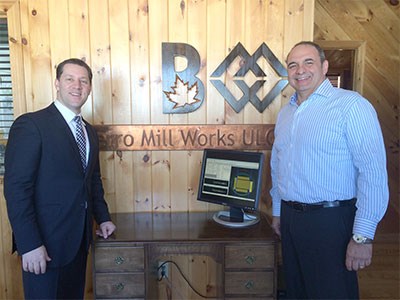Boniferro Mill Works is undertaking a $3-million expansion to bring its Sault Ste. Marie operations up to date with new technology that will allow the sawmill to meet the changing needs and expectations of the forest industry.
A $2-million company investment is being supplemented by $1 million from the Northern Ontario Heritage Fund Corp. (NOHFC) to purchase equipment and add between five and eight new workers to its current staff of 50. The final employee count will be determined after product flow is established.
CEO Jim Boniferro said the company had been steadily making improvements to the facility since it acquired the mill in 2003, starting with modifications that would allow it to handle hardwood lumber from the Algoma region. But more modern upgrades were needed. Some of the equipment dated back to the sawmill’s establishment in 1948, while the “newer” equipment dated back to the 1960s.
The investment by the NOHFC was the catalyst to push the upgrades to the next level.
“After we bought the place in 2003, we had a fair expansion in 2004 by adding a third saw line,” Boniferro said. “For the years in between, we continued to do maintenance and small upgrades and replace equipment that was absolutely necessary to replace, but this is the first opportunity that we’ve had to make this size of investment.”
The sizable expansion, which is introducing state-of-the-art technology to the mill for the first time, also sets the tone for the mill and its employees, Boniferro added.
“This is a long-term investment that says we won’t see our results overnight, but we will see that it’ll offer stability, it’ll offer new equipment that’s in this era, and this quality and this technology.”
In responding to the changing needs of an industry that’s been in a downturn for more than a decade, the company has had to figure out how to get the most out of its raw product while still being profitable.
The maple hardwood mill produces chips, bark and sawdust as byproduct, which is sold to buyers for use in the production of high-quality, glossy and specialty paper. But with a decrease in demand for those types of paper products, and therefore low-grade fibre, Boniferro said the mill has had to look at other options.
“We’re looking at how we could utilize that fibre as a manufacturer of a hardwood piece of lumber, and that’s the motivation for the modification: how do we utilize the fibre off of the Algoma unit that’s available to us and manufacture a higher grade product,” Boniferro said.
The electronics on the new equipment will allow the mill to process more wood, which will help to keep the unit cost down, he said.
Boniferro will also purchase a whole-log chipper to generate hardwood chips, which can then be used in biomass projects.
“If a company’s interested in making bio-oil or pellets, or any of the things that have been discussed in the last few years in the biomass business, we will have product market-ready and one step further down the production chain for them to utilize,” Boniferro said. “So, we’re hoping that it generates some further interest in other companies coming to Sault Ste. Marie because we have fibre.”
Boniferro Mill Works has presented as somewhat of an anomaly during the forestry downturn. While other mills have experienced shutdowns, layoffs and closures, Boniferro has remained in operation consistently for the last 12 years without long shutdowns or loss of employees.
Having fewer competing sawmills in the marketplace has translated to Boniferro taking on some additional customers, but more importantly, the CEO said, the company has reinforced its contracts with existing clientele.
“They don’t have as many places to go with our products and, likewise, we don’t have as many other places to go with our products,” Boniferro said. “So you develop some very, very strong partnerships, because all of our product goes to a secondary manufacturer.”
Boniferro Mill Works can also claim to be the longest operator of the sawmill since its inception in 1948. Previous owners have included Weyerhaeuser, E.B. Eddie and Domtar, and many of Boniferro’s employees have worked under four or five different companies during their tenure.




